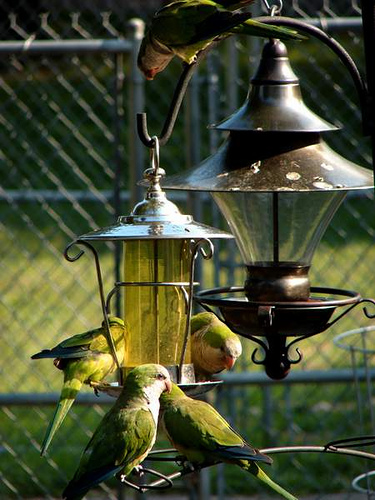 Monk parakeets at a feeder in ChicagoSome Hyde Parkers love their bright green plumage. Others find their squawking a nuisance. Many remain simply enchanted by the serendipity of their existence in this chilly northern climate.
Monk parakeets at a feeder in ChicagoSome Hyde Parkers love their bright green plumage. Others find their squawking a nuisance. Many remain simply enchanted by the serendipity of their existence in this chilly northern climate.
One way or another, every Hyde Park resident seems to have an opinion about the neighborhood’s population of feral monk parakeets, the birds that escaped domesticity and first took up residence in large communal nests built on electricity poles and tree limbs in the 1960s. Now, more than 40 years later, they’re finding new homes all over the Chicago area.
A team of scientists from three Chicago universities estimate there are now at least 500 nests around the city, and have found locations as many as 20 miles away from Hyde Park.
“We’re watching an invasion as it’s happening,” said Emily Minor, an assistant professor of biological sciences at the University of Illinois at Chicago and a member of the research team. “We’re trying to find the location of every nest in the city and surrounding areas so we can learn more about habitat preferences, why they chose to nest in certain places and also the pattern of where they spread and where they may be going.”
 The birds live in huge communal nests built on power line poles or tree branches and, like this one, can extend many feet. Courtesy of Christopher Appelt, St. Xavier UniversityMinor is a landscape ecologist who studies environmental patterns at broad spatial scales using tools such as Global Information System mapping software. She joined Stephen Pruett-Jones of the University of Chicago and Christopher Appelt of south suburban St. Xavier University on the parakeet project after learning about their work.
The birds live in huge communal nests built on power line poles or tree branches and, like this one, can extend many feet. Courtesy of Christopher Appelt, St. Xavier UniversityMinor is a landscape ecologist who studies environmental patterns at broad spatial scales using tools such as Global Information System mapping software. She joined Stephen Pruett-Jones of the University of Chicago and Christopher Appelt of south suburban St. Xavier University on the parakeet project after learning about their work.
To track the birds, the researchers are enlisting the help of the public. The team has created an online survey for citizens to fill out when they observe a parakeet nest.
Undergraduate research assistants from the universities will then visit the reported locations to take GPS data and record information about the nests’ size and any birds observed there.
View Monk Parakeets in a larger map
According to Amela Jakupovic, an undergraduate research assistant working with Minor at UIC, people aren’t just replying to the survey with information, but also with their stories about the birds.
“They’re bright green birds,” she said, “people notice them and are often really fond of them.”
Similar parakeet populations have thrived in other large cities such as San Francisco and New York, but Chicago’s proximity to farmland causes some concern. In their native Argentina, monk parakeets are agricultural pests.
“They could potentially become crop pests here,” Minor said. “We’re hoping our work could help future management decisions.”
Few of the survey respondents are worried about that yet, though.
“I knew a lot of people really liked these birds,” Minor said. “But I’ve been surprised by how eager they are to share their experiences."